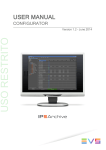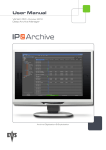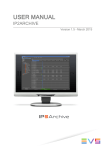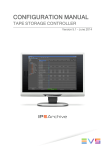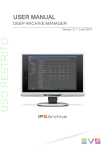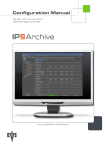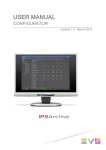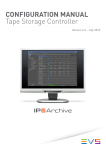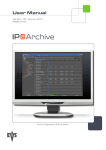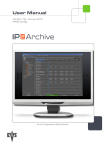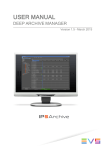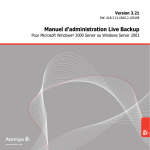Download IP2A configurator user manual 1.0
Transcript
USER MANUAL Configurator Version 1.0 - July 2013 IP2Archive - User Manual - Configurator Version 1.0 Copyright EVS Broadcast Equipment S.A.– Copyright © 2003-2013. All rights reserved. Disclaimer The information in this manual is furnished for informational use only and subject to change without notice. While every effort has been made to ensure that the information contained in this user manual is accurate, up-to-date and reliable, EVS Broadcast Equipment cannot be held responsible for inaccuracies or errors that may appear in this publication. Improvement Requests Your comments will help us improve the quality of the user documentation. Do not hesitate to send improvement requests, or report any error or inaccuracy on this user manual by e-mail to [email protected]. Regional Contacts The address and phone number of the EVS headquarters are usually mentioned in the Help > About menu in the user interface. You will find the full list of addresses and phone numbers of local offices either at the end of this user manual (for manuals on hardware products) or at the following page on the EVS website: http://www.evs.com/contacts. User Manuals on EVS Website The latest version of the user manual, if any, and other user manuals on EVS products can be found on the EVS download center, on the following webpage: http://www.evs.com/downloadcenter. I EVS Broadcast Equipment S.A. - July 2013 II Issue 1.0.D IP2Archive - User Manual - Configurator Version 1.0 1. About the Application Configurator is an application which allows a system administrator to configure the IP2Archive applications. It also allows to create users for the IP2Archive system and manage their user rights. 1. About the Application 1 EVS Broadcast Equipment S.A. - July 2013 Issue 1.0.D 2. Installing the Application 2.1. How to Install the Application To install the application, proceed as follows: 1. Double-click the IP2Archive.exe to launch the IP2Archive Setup Wizard. The Welcome screen appears. 2. Click Next to continue. The End-User License Agreement screen appears. 3. Read the license agreement on using IP2Archive in your country. Accept the agreement and click Next to continue. The Installation Folder screen appears. 2 2. Installing the Application IP2Archive - User Manual - Configurator Version 1.0 4. Select the folder where the application has to be installed and click Next to continue. By default, the IP2Archive applications will be installed in the following folder: C:\Program Files\EVS Broadcast Equipment\IP2Archive\(for 32-bit machines) or C:\Program Files (x86)\EVS Broadcast Equipment\IP2Archive\ (for 64-bit machines). The Setup Type screen appears. 5. Choose a setup type and click Next to continue. You can choose one of the following setup types: ◦ Complete: Installs all IP2Archive applications. Continue to step 7. ◦ Typical: Installs the most common IP2Archive applications, i.e. the database client software, the Deep Archive Manager, Configurator and the EVS Software Player. Continue to step 7. By default, this installation type is selected. ◦ Custom: Allows you to select the IP2Archive applications that have to be installed. The Custom Setup screen appears. Continue to step 6. 6. In the Custom Setup screen, select the applications that you want to install, and then click Next to continue. 2. Installing the Application 3 EVS Broadcast Equipment S.A. - July 2013 Issue 1.0.D The Custom Setup screen shows a tree view of the IP2Archive applications that you can install. By default, Deep Archive Manager, the database client software, the EVS Software Player, the IP2Archive documentation and Configurator are selected. When you click a feature or subfeature, a description of the feature will be displayed and also the disk space requirements. To add or remove a feature, click the arrow next to the feature name, and then choose one of the following options from the drop-down list: ◦ Will be installed on local hard drive: Installs the selected feature in the location shown under Installation Folder. ◦ Entire feature will be installed on local hard disk: Installs the selected feature and all subfeatures. ◦ Feature will be installed when required:The feature will be installed when you perform an action that requires it. ◦ Entire feature will be unavailable: For a new installation of IP2Archive, this option passes over the installation of the selected feature. For an existing installation, this option removes the feature from the installation. After you select this option, a red X appears on the feature tree next to the feature name.This option cannot be selected for the database client software, the EVS Software Player and the IP2Archive documentation. Click the Reset button to undo your selection. 7. Do one of the following: ◦ 4 If no database client software has been installed yet, the Database Connection Creation screen appears. 2. Installing the Application IP2Archive - User Manual - Configurator Version 1.0 Enter the IP address of the database server. The default port number, i.e. 1521, has already been entered. Click Next to continue. ◦ If the database client software has already been installed, the Database Selection screen appears. Select the database name from the drop-down list and enter the username and password necessary to log onto the database. You can test the connection with the database by clicking the Test Login button. Click Next to continue. To add a new database, click the New Database button and enter the database name (by default IP2A.EVS), the IP address and port number (by default 1521) of the machine that hosts the database, and the service name (by default TOM). You can test the connection with the database by clicking the Test Login button. Click Next to continue. 2. Installing the Application 5 EVS Broadcast Equipment S.A. - July 2013 Issue 1.0.D 8. Click Install to start the installation. The selected applications will be installed. 6 2. Installing the Application IP2Archive - User Manual - Configurator Version 1.0 9. If the installation has been completed, click Finish to exit the Setup Wizard. ◦ If the View Readme File check box is selected, a text file containing the IP2Archive release notes will be opened. ◦ If the second check box is selected, the Configurator application will be launched. This application will allow to configure the installed applications. The installed IP2Archive applications and a link to the IP2Archive documentation will appear in the Windows Start menu. 10. Open the IP2Archive installation folder, and right-click the application you want to create a shortcut to. 11. Click Create Shortcut. 12. Drag the shortcut to the Desktop. 2. Installing the Application 7 EVS Broadcast Equipment S.A. - July 2013 2.2. Issue 1.0.D How to Modify, Repair or Remove the Installation To modify, repair or remove the installation of the application, proceed as follows: 1. Double-click the IP2Archive.exe to launch the IP2Archive Maintenance Wizard. The Welcome screen appears. 2. Click Next to continue. The Modify, Repair or Remove Installation screen appears. 3. Do one of the following: 8 ◦ If you want to modify the IP2Archive installation, e.g. add or remove certain applications, select Modify and click Next. Continue to step 4. ◦ If you want to repair the IP2Archive installation, e.g. fixing missing or corrupt files, shortcuts and registry entries, select Repair and click Next. Continue to step 6. 2. Installing the Application IP2Archive - User Manual - Configurator Version 1.0 ◦ If you want to remove the IP2Archive installation, select Remove and click Next. Continue to step 7. 4. In the Custom Setup screen, select the applications that you want to (de)install. The Custom Setup screen shows a tree view of the IP2Archive applications that you can install and deinstall. By default, Deep Archive Manager, the database client software, the EVS Software Player, the IP2Archive documentation and Configurator are selected. When you click a feature or subfeature, a description of the feature will be displayed and also the disk space requirements. To add or remove a feature, click the arrow next to the feature name, and then choose one of the following options from the drop-down list: ◦ Will be installed on local hard drive: Installs the selected feature in the location shown under Installation Folder. ◦ Entire feature will be installed on local hard disk: Installs the selected feature and all subfeatures. ◦ Feature will be installed when required:The feature will be installed when you perform an action that requires it. ◦ Entire feature will be unavailable: For a new installation of IP2Archive, this option passes over the installation of the selected feature. For an existing installation, this option removes the feature from the installation. After you select this option, a red X appears on the feature tree next to the feature name.This option cannot be selected for the database client software, the EVS Software Player and the IP2Archive documentation. Click the Reset button to undo your selection. Click Next to continue. 5. Click Install to start the installation. 2. Installing the Application 9 EVS Broadcast Equipment S.A. - July 2013 Issue 1.0.D Any features that you have added in the Custom Setup screen will be installed. Any features that you have removed will be uninstalled. The installed features that you haven't modified will be skipped. Continue to step 8. 6. Click Repair to repair the installation of EVS IP2Archive. Continue to step 8. 7. Click Remove to remove IP2Archive from your computer. 10 2. Installing the Application IP2Archive - User Manual - Configurator Version 1.0 8. Click Finish to exit the Setup Wizard. 2. Installing the Application 11 EVS Broadcast Equipment S.A. - July 2013 3. Starting the Application 3.1. After Installation Issue 1.0.D Double-click the Configurator icon on your desktop to start the application. You can also start the application by double-clicking the executable file (.exe) in the installation folder. The splash screen appears. The application logs into the database. Then, the Settings window appears allowing you to configure the application. See section "Settings Window" on page 60. 3.2. After Configuration Double-click the Configurator icon on your desktop to start the application. You can also start the application by double-clicking the executable file (.exe) in the installation folder. The splash screen appears. The application logs into the database. Then, a Login dialog box appears. 12 3. Starting the Application IP2Archive - User Manual - Configurator Version 1.0 To be able to log into the application, you need to belong to a user group that has a role which allows to use the application. Enter your username and password and click Login. The main window of the application opens. You get an error notification if: • you have entered a wrong username or password. • you have omitted your username. • you have insufficient user rights. • your user account has expired. 3. Starting the Application 13 EVS Broadcast Equipment S.A. - July 2013 3.3. Issue 1.0.D Main Window Overview General Description The main window allows you to view and switch between the various setup panes of Configurator. Illustration The main window contains the areas highlighted on the screenshot below: Area Description The table below describes the various parts of the main window: Part 14 Name Description 1. Menu Bar The menu bar contains three menus: File, Settings and Help. 2. Selected Setup Pane This area displays the selected setup pane. Each setup pane allows you to configure specific settings. 3. Navigation bar The Navigation bar allows you to navigate between the eight Setup panes. They can be accessed by clicking the corresponding icon. 3. Starting the Application IP2Archive - User Manual - Configurator Version 1.0 Menu Bar The menu bar contains three menus: File, Settings and Help. The File menu contains only one command: Exit. It is used to exit the application. Click the File menu or use the keyboard shortcut keys ALT + F or F10 + F to open it. Click Exit or use the keyboard shortcut key X to exit the application. The Settings menu doesn’t contain any commands. It immediately gives access to the application settings. Click the Settings menu or use the keyboard shortcut keys ALT + S or F10 + S to access the settings. The Help menu contains the following commands: About and Help. With the About command the application splash screen can be opened. The splash screen displays the application software version, the name of the database the application is logged on to and the login name used. With the Help command you can open the application help file. Click the Help menu or use the keyboard shortcut keys ALT + H or F10 + H to open it. Click About or use the keyboard shortcut key A to open the splash screen. Click Help or use the keyboard shortcut key H to open the application help file. Setup Categories The settings are grouped according to three setup categories: Setup Category Description Connections Settings related to the connection between IP2Archive and IPDirector, and between IP2Archive and the HSM system. Settings Settings related to specific IP2Archive applications. Rights Settings related to user rights. Setup Panes The following table briefly describes each Setup pane: Setup Pane Description IPDirector This pane allows you to configure the connection between IPDirector and particular IP2Archive applications. See section "Configuring the Connection with IPDirector" on page 17. HSM This pane allows you to configure the connection between IP2Archive and the hierarchical storage management system (HSM). See section "Configuring the HSM Connection" on page 24. General This pane allows you to configure settings specific to the Deep Archive Manager. See section "Configuring Deep Archive Manager" on page 33. Application Monitor This pane allows you to configure the Application Monitor. See section "Configuring Deep Archive Manager" on page 33. 3. Starting the Application 15 EVS Broadcast Equipment S.A. - July 2013 16 Issue 1.0.D Setup Pane Description Relations This pane allows you to create and manage users and contacts for the IP2Archive system, and to assign user rights and resources to them. See section "Managing Relations" on page 44. Roles This pane gives an overview of the user rights (=roles). It allows you to add a description to each user right. See section "Managing User Rights" on page 53. Groups This pane gives an overview of the existing user groups. It allows you to create new user groups and delete existing ones. See section "Managing User Rights" on page 53. 3. Starting the Application IP2Archive - User Manual - Configurator Version 1.0 4. Configuring Connections 4.1. Configuring the Connection with IPDirector 4.1.1. Introduction The connection between IPDirector and IP2Archive can be configured in the IPDirector setup pane. It allows you to: 4.1.2. • create a connection with an IPDirector in your setup • configure the connection between the SOAP API of the IPDirector of your choice and the IP2Archive applications • configure the connection between the local SOAP notification server of IP2Archive Communicator and IPDirector • specify the archive and process bins in IPDirector IP2Archive Communicator has to monitor • specify the archive metadata userfields in IPDirector IP2Archive Communicator and Deep Archive Sync have to update. Creating an IPDirector Connection If your setup has more than one IPDirector, Configurator allows you to create and configure a connection between IP2Archive and each of these IPDirectors. The creation is done in the IPDirector Name area. 4. Configuring Connections 17 EVS Broadcast Equipment S.A. - July 2013 Issue 1.0.D To create a connection with a particular IPDirector, click the New button. Enter a name for the IPDirector you want to connect with and click the OK button. The name will appear in the IPDirector Name field. You can now start configuring the connection. To switch between the connection settings of two IPDirectors, select the name of the desired IPDirector from the IPDirector Name drop-down list. To delete a particular connection, select the name of the desired IPDirector from the IPDirector Name drop-down list and click the Delete button. Click OK to confirm your action. Note that if you delete a connection, all corresponding settings will be lost. 4.1.3. Configuring the Connection with the IPDirector API The API tab allows you to configure the connection between the IPDirector SOAP API and the IP2Archive Applications (Deep Archive Manager, Deep Archive Sync, IP2Archive Communicator, Deep Archive Controller). In the IPDirector API Settings group box you have to enter the data these applications need to be able to communicate with the IPDirector API. The following data has to be entered: 18 • API Host: The IP address or hostname of the server that hosts the IPDirector API. • Login: The login necessary to log into the IPDirector API. • Password: The password necessary to log into the IPDirector API. • WSDL: The path to the IPDirector API .wsdl file. This path is is automatically entered based on the IP address of the server that hosts the IPDirector API. 4. Configuring Connections IP2Archive - User Manual - Configurator Version 1.0 A Test button is provided allowing you to test the connection with the IPDirector API. If all data is correct, the message ‘Connected’ will appear. Otherwise, the message ‘Connection Failed’ will appear. In the Cmnd. Timeout field you can set the number of seconds to wait while IPDirector attempts to execute a command, before canceling the attempt and generate an error. By default, a time interval of 10 seconds is set. By default, the API maintains a session for 1 hour. After a period of no activity, the session expires automatically. In the Token Keep Alive field you can set a time interval after which the session timeout is reset to prevent the session from timing out. By default, this is after 10 minutes. If you select the option Extended Log Enabled, additional information will be inserted in the application logs. For example, the API messages and parameters sent by the SOAP API client (= the application). By default, this option is not selected. If you select the option Trace Enabled,even more detailed information will be inserted in the application logs,namely the entire SOAP messages sent between the SOAP API client (= the application) and the SOAP API server (= IPDirector API). By default, this option is not selected. 4.1.4. Configuring the Local SOAP Notification Server The API tab also allows you to configure the connection between IPDirector and the local SOAP notification server that forms part of the IP2Archive Communicator. The IP2Archive Communicator receives notifications from IPDirector through a local SOAP notification server, for example, when a new clip has been created in IPDirector, the archive status of a clip has changed, or when a clip has been moved to a particular archive bin. In the IPDirector API Notification Settings group box you have to enter the data which is necessary for IPDirector to send notifications to the SOAP notification server. The following data has to be entered: • Server Local Host: The IP address or hostname of the server on which IP2Archive Communicator runs. • WSDL: The path to the IPDirector Communicator API .wsdl file. This path is automatically entered based on the IP address of the server on which IP2Archive Communicator runs. • Server Local Port: The port on which the local SOAP notification server listens for notifications of IPDirector. By default, this is 30677, and it should only be altered if there are issue with firewalls or port conflicts. 4. Configuring Connections 19 EVS Broadcast Equipment S.A. - July 2013 Issue 1.0.D If you select the option Trace Enabled,more detailed information will be inserted in the application logs, namely the entire SOAP messages sent between the SOAP API client (=IPDirector API) and the SOAP API server (= the application). By default, this option is not selected. 4.1.5. Configuring the IP2Archive Archive and Restore Process Bins Introduction When installing and configuring IP2Archive, an Archive and Restore bin hierarchy is created in the Database Explorer of IPDirector. This bin hierarchy allows users to easily request the archiving and restoring of certain clips by dragging them to a specific bin within this hierarchy. It also allows them to keep track of the archive and restore process of each clip. Depending on their archive or restore status, clips will be moved from one bin in the hierarchy to another. Each bin represents a particular stage in the archive or restore process. These bins have to be monitored by the IP2Archive Communicator and the Deep Archive Sync application. The IP2Archive Communicator will check for archive and restore requests and pass this on to IP2Archive. Both applications will check the archive and restore status of the clips and move them to another bin if the status changes. 20 4. Configuring Connections IP2Archive - User Manual - Configurator Version 1.0 Bins Tab The Bins tab allows you to specify which bins should be scanned by IP2Archive and Deep Archive Sync. Note Before you start configuring this tab, make sure you have already configured the connection with the IPDirector API. See section "Configuring the Connection with the IPDirector API" on page 1. Otherwise, an error message will appear if you open the Bins tab. Also, the drop-down lists where you have to select the bins will be empty. Linking Archive and Restore Process Bins In the Archive Process Bins group box the names of the archive process bins that have to be scanned are displayed. For each bin, you have to select the name of the corresponding bin in IPDirector from a drop-down list. Note that if you haven't configured the connection with the IPDirector API yet, the drop-down list will be empty. You have to do the same for the restore process bins in the Restore Process Bins group box. Set Request Bin Scan Frequency The Request Bin Active Scan Delay field allows you to set how frequently (in seconds) IP2Archive Communicator has to scan the Request Archive and the Request Restore bin. By default, this is every 10 seconds. If you set this to 0, no scanning will be performed. 4. Configuring Connections 21 EVS Broadcast Equipment S.A. - July 2013 Issue 1.0.D Moving Externally Requested Clips on Status Change If you enable the option Add External Requested Clips to Bins on Status Change, IP2Archive Communicator will not only move the clips that were requested in IPDirector to be archived or restored to another bin on status change, but also the clips that were requested to be archived or to be restored outside IPDirector, i.e. in the Deep Archive Manager. By default, this option is selected. 4.1.6. Configuring the Archive Metadata Profile and User Fields Introduction To be able to monitor the progress and status of the archive and restore process of the clips in the Database Explorer of IPDirector, metadata is added to the clips by means of specific userfields. For example, Archive Status, Archive Progress, Archive Date, etc. These userfields are linked to one or more metadata profiles. IP2Archive Communicator and Deep Archive Sync will check the IP2Archive database for the status of these clips and then update the content of the corresponding userfields in IPDirector. Metadata Tab The Metadata tab allows you to specify the IPDirector metadata profile and the corresponding userfields that have to be updated by both applications. 22 4. Configuring Connections IP2Archive - User Manual - Configurator Version 1.0 Note Before you start configuring this tab, make sure you have already configured the connection with the IPDirector API. See section "Configuring the Connection with the IPDirector API" on page 1. Otherwise, an error message will appear if you open the Metadata tab. Also, the drop-down lists where you have to select the userfields and the metadata profile will be empty. Selecting the Archive Metadata Profile The Archive Metadata Profile group box displays a grid with the names of the available metadata profiles retrieved from IPDirector. If you haven't configured the connection with the IPDirector API yet, this list will be empty. Select the Default check box of the IP2Archive metadata profile. If a clip has no metadata profile assigned to it yet in IPDirector, the IP2Archive Communicator will assign the metadata profile you have marked as being the default profile. To avoid that the userfields linked to the other metadata profiles appear in the drop-down lists of the Archive Metadata Userfields group box, select the corresponding Ignore check box. Selecting the Archive Metadata Userfields In the Archive Metadata Userfields group box the names of the userfields that have to be updated are displayed. For each userfield, you have to select the name of the corresponding userfield in IPDirector from a drop-down list.Once you have selected a user field, the type of user field (text, combo box, date) will be displayed next to it. If you haven't configured the connection with the IPDirector API yet, this list will be empty. 4. Configuring Connections 23 EVS Broadcast Equipment S.A. - July 2013 Issue 1.0.D 4.2. Configuring the HSM Connection 4.2.1. Introduction The HSM setup pane allows you to configure the connection between IP2Archive and the hierarchical storage management system. The connection with the following HSM systems can be configured: 4.2.2. • Front Porch Digital DIVArchive • XenData Digital Archive • SGL FlashNet • Atempo Digital Archive Selecting the Type of HSM To be able to configure the connection between IP2Archive and the Hierarchical Storage Management System (HSM) in your setup, you first have to select the type of HSM from the HSM field. Once selected, the corresponding settings will appear. 24 4. Configuring Connections IP2Archive - User Manual - Configurator Version 1.0 4.2.3. Configuring the DIVA Connection Entering the Connection Data In the Connection group box you have to enter the data Tape Storage Controller needs to connect with Front Porch Digital's DIVArchive. The following data has to be entered: • Manager: The name of the DIVArchive Manager. The DIVArchive Manager is the main component in a DIVArchive system. All archive operations are controlled and handled by the DIVArchive Manager. • Address: The IP address of the management station running the DIVArchive Manager software component. • Port: The listening port number of the DIVArchive Manager management station. By default, this is 9000. A Test button allows you to test the connection with DIVArchive. If the connection is ok, the message ‘Success’ will appear. Otherwise, an error message will appear. Click the Save button to save your settings. Click the Undo button to undo the information you have just entered or modified. Setting the Maximum Number of Archive and Restore Requests The Storages area allows you to the set maximum number of archive and restore requests that will be simultaneously sent to the DIVArchive by Tape Storage Controller. By default, 2 archive and 2 restore requests will be sent at the same time. 4. Configuring Connections 25 EVS Broadcast Equipment S.A. - July 2013 Issue 1.0.D You also have to enter the name of the default tape group. A group is a logical association of tapes in the LTO tape library, for example Movies, Arts, Commercials. The name of the default group has to match the name as configured in the Sets and Groups tab of the Configuration Utility of DIVArchive. Click the Save button to save your settings. Click the Undo button to undo the information you have just entered or modified. Entering LTO Tape IDs Introduction The Tape Storage tab contains vital information about the LTO tapes in the tape library. You have to add the ID of the LTO tapes that are available in the tape library. This is necessary because the Tape Storage Controller application that communicates with the DIVArchive system cannot obtain this list from the DIVArchive database through the DIVArchive API. You can add single tape IDs by clicking the Add button, but you can also import a list containing multiple tape IDs by clicking the Import Batch button. Each tape has a unique ID. This ID can be the ID assigned to the tape by the tape manufacturer, e.g. T0001, but can also be a custom ID assigned in agreement with the customer. This custom ID will consist of maximum six characters, e.g. EVS001. The list containing the tape IDs is a simple text file. The IDs have to be entered in the text file below each other as exemplified in the image below. 26 4. Configuring Connections IP2Archive - User Manual - Configurator Version 1.0 How to Add a Single Tape ID To add a single tape ID, proceed as follows: 1. Click the Add button. ◦ If tape set ID 0 is selected, a warning message appears. This is because normally no tapes are assigned to tape set 0. Click No to abort the operation and select a different tape set ID first. ◦ If tape set ID 0 is not selected, or if you click Yes, the Add Tapes dialog box appears. 2. Select the Single Tape radio button. 3. Enter the tape ID. 4. Click Add to add the tape ID to the list of tape IDs or Cancel to cancel the operation. How to Add a Tape Range To add a range of tapes, proceed as follows: 1. Click the Add button. ◦ If tape set ID 0 is selected, a warning message appears. This is because normally no tapes are assigned to tape set 0. Click No to abort the operation and select a different tape set ID first. ◦ 4. Configuring Connections If tape set ID 0 is not selected, or if you click Yes, the Add Tapes dialog box appears. 27 EVS Broadcast Equipment S.A. - July 2013 Issue 1.0.D 2. Select the Tape Range radio button. 3. In the Prefix field, enter the default prefix that should be added to each tape ID belonging to the tape range, e.g. ‘T’. A preview is given of the new tape IDs. 4. In the Start field, select or type the start number of the first tape ID. 5. In the End field, select the end number of the last tape ID. 6. In the Length field, specify the length, i.e. the number of characters, of the tape ID. 7. Click the Add button to add the tape IDs or Cancel to cancel the operation. 28 4. Configuring Connections IP2Archive - User Manual - Configurator Version 1.0 4.2.4. Configuring the XenData Connection Entering the Connection Data In the XenData Configuration group box you can configure the connection between the File Transfer Daemon and the API of the XenData hierarchical storage management system Digital Archive. You have to enter the following information: • XenData Root Folder: The root location of the XenData hard disk. • XenData Subfolder: The path of a folder on this XenData hard disk where the files to be archived will be stored. • Maximum Number of Transfers: The maximum number of file transfers that can be simultaneously performed by the File Transfer Daemon. The XenData root folder path is necessary to be able to make connection with the XenData API. The XenData root folder and XenData subfolder path combined represent the location on the XenData hard disk where the files to be archived to LTO will be transferred to by the File Transfer Daemon. Click the Save button to save your settings. Click the Undo button to undo the information you have just entered or modified. Setting the Maximum Number of Archive and Restore Requests The Storages area allows you to the set maximum number of archive and restore requests that will be sent simultaneously to XenData by the File Transfer Daemon. By default, 2 archive and 2 restore requests will be sent at the same time. Click the Save button to save your settings. Click the Undo button to undo the information you have just entered or modified. 4. Configuring Connections 29 EVS Broadcast Equipment S.A. - July 2013 4.2.5. Issue 1.0.D Configuring the FlashNet Connection Entering the Connection Data The FlashNet Connection group box allows you to configure the connection between the Tape Storage Controller and SGL's hierarchical storage management system FlashNet. The following connection data has to be entered: • Host : The IP address or machine name of the FlashNet server. • Port: The listening port number of the FlashNet server. The default port number is 8199. • Application Host: The IP address or machine name of the server that hosts Tape Storage Controller. In the Reply Timeout field you have to enter how many seconds Tape Storage Controller will wait for the FlashNet server to respond after making connection before giving an error . By default, this is set to 60 seconds. If you select the Logging Enabled check box, extra logs related to FlashNet will be added to the application log files. By default, this option is selected. If you select the Trace Enabledcheck box, the XML communication between Tape Storage Controller and FlashNet is added to the log files. By default, this option is not selected. The Test button can be used to test the connection with the FlashNet server. Click the Save button to save your settings. Click the Undo button to undo the information you have just entered or modified. Setting the Maximum Number of Archive and Restore Requests The Storages area allows you to the set maximum number of archive and restore requests that will be simultaneously sent to FlashNet by Tape Storage Controller. By default, 2 archive and 2 restore requests will be sent at the same time. 30 4. Configuring Connections IP2Archive - User Manual - Configurator Version 1.0 You also have to enter the name of the default tape group. A group is a logical association of tapes in the LTO tape library, for example Movies, Arts, Commercials. The name of the default group has to match the name as configured in the Media Group Management window of FlashNet. Click the Save button to save your settings. Click the Undo button to undo the information you have just entered or modified. 4.2.6. Configuring the ADA Connection Entering the Connection Data The ADA group box allows you to configure the connection between the Tape Storage Controller and the Atempo Digital Archive (ADA) system. Entering the Connection Data In the Connection group box you have to enter the following connection data: • User: The name of the user as defined in Atempo Digital Archive. • Domain: The Windows domain name. • Password: The password necessary to log into Atempo Digital Archive. • Server Name: The name of the Atempo Digital Archive Server to which Tape Storage Controller will connect. You have to use the machine name. • Port: The number of the port the Atempo Digital Archive Server will listen for requests. By default, this is port 80. • Database: The database instance used for Atempo Digital Archive. It is called ADA by default. Specifying the ADA Archive In the ADA Archive group box you have to enter the following data: • Archive: The name of the project archive created in Atempo Digital Archive. A project archive is shared and can be accessed by several users defined by the Administrator. • Path: The folder of the project archive which mirrors the location of the data on the source platform. This folder has a path of the structure: <source_machine>\<source_ machine_OS>\root_path_on_source>. 4. Configuring Connections 31 EVS Broadcast Equipment S.A. - July 2013 Issue 1.0.D Specifying the Host Platform A host platform is an archiving platform where the source data to be archived is located. In the Host Platform group box you have to enter the network name of the machine hosting the data. This name can be derived from the UNC path of the storage or this can be a fixed name. The first option is used when there are multiple storages, the second option is used when there is only one storage. Enabling Logging If you select the option Enable Logging, an extensive log will be kept of the communication between Tape Storage Controller and the Atempo Digital Archive Server. Click the Test button to test this option. Enabling Retrieval of LTO Tape ID If you select the option Retrieve Tape ID After Archiving Has Finished, Tape Storage Controller will retrieve from the ADA database the ID of the LTO tape which contain the archived files. Click the Save button to save your settings. Click the Undo button to undo the information you have just entered or modified. Setting the Maximum Number of Archive and Restore Requests The Storages area allows you to the set maximum number of archive and restore requests that will be sent simultaneously to ADA by Tape Storage Controller. By default, 2 archive and 2 restore requests will be sent at the same time. Click the Save button to save your settings. Click the Undo button to undo the information you have just entered or modified. 32 4. Configuring Connections IP2Archive - User Manual - Configurator Version 1.0 5. Configuring Settings 5.1. Configuring Deep Archive Manager 5.1.1. Introduction The General setup pane allows you to configure certain features of the Deep Archive Manager. The following features can be configured 5.1.2. • the automatic archiving, restoring and purging of clips and the automatic removal of the high-resolution video file from the IPDirector nearline • the deriving of the content type of the clips that enter Deep Archive Manager • the language of the user interface. Configuration Tab Introduction The Configuration tab allows you to configure the Deep Archive Manager. You can specify by means of filters which types of clips: • have to be automatically archived • have to be automatically refused • have to be automatically purged. 5. Configuring Settings 33 EVS Broadcast Equipment S.A. - July 2013 Issue 1.0.D You can also specify for which types of clips, once archived, the high-resolution video file has to be automatically removed from the IPDirector nearline. Filter Criteria The following filter criteria are available: • VarID: VarID of the clip. By default, the wildcard character * is entered. • Filepath: path of the folder where the high-resolution video files are stored. By default, the wildcard character * is entered. • Clipname: name of the clip. By default, the wildcard character * is entered. • Video formats: video format of the media assets that are linked to the clip. Multiple video formats can be selected. By default, the option None selected is selected. • Origin: source via which the clip was entered in the deep archive system. Multiple origins can be selected. By default, the option None selected is selected. • Content Types: categorization of the content of a clip. Multiple content types can be selected. By default, the option None selected is selected. Regular Expressions In the VarID, Filepath and Clipname field you can enter regular expressions that Deep Archive Manager will use to recognize certain strings of text, such as particular characters, words, or patterns of characters, in the VarID, filepath or clipname of clips. Priority of Filters The filters are displayed in order of priority. Deep Archive Manager will start from the top of the list. It will search for clips that match the criteria of the first filter and execute the request. If there are no more clips that match the criteria, it will search for clips that match the criteria of the second filter, etc. You can change the order of priority by means of 34 and . 5. Configuring Settings IP2Archive - User Manual - Configurator Version 1.0 Adding an Archive Filter Depending on your user rights, you will be able to add an archive filter or not. If you don't have the necessary rights, the Archive icon will not be visible. To add an archive filter, proceed as follows: 1. Click the Archive icon to open the Archive pane. 2. Enter and/or select the desired filter criteria. 3. Click the Add button. A new archive filter is added to the archive filter list. By default, New archive filter is entered as name for the filter. 4. (Optional) Enter a new name for the filter. 5. (Optional) Select the Auto Archive check box. If selected, clips that correspond to the selected filter criteria will be automatically archived by Deep Archive Manager. 6. (Optional) Edit the other filter data. 7. Click the Save button to save the archive filter in the database. If you don't save your filter and leave the pane, a message will appear asking you to save your changes. 8. Click Save. Adding a Refuse Archive Filter Depending on your user rights, you will be able to add a refuse archive filter or not. If you don't have the necessary rights, the Refuse Archive icon will not be visible. To add a refuse archive filter, proceed as follows: 1. Click the Refuse Archive icon to open the Refuse Archive pane. 2. Enter and/or select the desired filter criteria. 3. Click the Add button. A new refuse archive filter is added to the refuse archive filter list. By default, New Refuse archive filter is entered as name for the filter. The Auto Refuse check box is automatically selected. 4. (Optional) Enter a new name for the filter. 5. In the Retention period field, enter the time (in hours) after which Deep Archive Manager will automatically refuse the clips and move them from the Archive Candidates tab to the Refused tab. The retention period starts from the moment when the clip is dropped in the Request Archive bin in IPDirector (displayed in the Deep Archive Manager as Creation date). 6. (Optional) Edit the other filter data. 7. Click the Save button to save the refuse archive filter in the database. If you don't save your filter and leave the pane, a message will appear asking you to save your changes. 5. Configuring Settings 35 EVS Broadcast Equipment S.A. - July 2013 Issue 1.0.D 8. Click Save. Adding a Remove Hires Filter Depending on your user rights, you will be able to add an remove hires filter or not. If you don't have the necessary rights, the Remove Hires icon will not be visible. To add a remove hires filter, proceed as follows: 1. Click the Remove Hires icon to open the Remove Hires pane. 2. Enter and/or select the desired filter criteria. 3. Click the Add button. A new remove hires filter is added to the remove hires filter list. By default, New Remove hires filter is entered as name for the filter. 4. (Optional) Enter a new name for the filter. 5. (Optional) Select the Auto remove check box. If selected, the hires file of clips that correspond to the selected filter criteria will be automatically removed by Deep Archive Manager after a certain period of time from the nearline storage. 6. In the Retention period field, enter the time (in days) after which Deep Archive Manager will automatically remove the hires file of the clips. The retention period starts from the moment when the clip is dropped in the Request Archive bin in IPDirector (displayed in the Deep Archive Manager as Creation date). 7. (Optional) Edit the other filter data. 8. Click the Save button to save the remove hires filter in the database. If you don't save your filter and leave the pane, a message will appear asking you to save your changes. 9. Click Save. Adding a Purge Filter Depending on your user rights, you will be able to add an purge filter or not. If you don't have the necessary rights, the Purge icon will not be visible. To add a purge filter, proceed as follows: 1. Click the Purge icon to open the Purge pane. 2. Enter and/or select the desired filter criteria. 3. Click the Add button. 36 5. Configuring Settings IP2Archive - User Manual - Configurator Version 1.0 A new purge filter is added to the purge filter list. By default, New Purge Filter is entered as name for the filter. 4. (Optional) Enter a new name for the filter. 5. (Optional) Select the Auto Purge check box. If selected, the high-resolution file of the clips that correspond to the selected filter criteria will be automatically purged from LTO after a certain period of time. 6. In the Retention period field, enter the time (in days) after which Deep Archive Manager will automatically request the purge of the high-resolution file from LTO and the removal of the high-resolution and low-resolution file from the nearline storage. The retention period starts from the moment when the clip is dropped in the Request Archive bin in IPDirector (displayed in the Deep Archive Manager as Creation date). 7. (Optional) Edit the other filter data. 8. Click the Save button to save the purge filter in the database. If you don't save your filter and leave the pane, a message will appear asking you to save your changes. 9. Click Save. Editing Filters To edit one or more filters, proceed as follows: 1. Select each time the filter you want to edit. 2. Change the necessary data. 3. Do one of the following: ◦ Click the Post button or select another filter to save the changes in the memory of Deep Archive Manager. The changes are not yet saved in the database. ◦ Click the Cancel button to undo the changes you made to the selected filter. ◦ Click the Undo button to undo all the changed filters. ◦ Click the Save button to save all the changed filters in the database. Deleting a Filter To delete a filter, proceed as follows: 1. Select the filter from the list and click the Delete button . A confirmation dialog box appears. 2. Click OK to continue. The filter is removed from the list. 3. Click the Save button to save the change to the database. 5. Configuring Settings 37 EVS Broadcast Equipment S.A. - July 2013 5.1.3. Issue 1.0.D Content Types Tab The Content Types tab is used to specify the possible content types of the clips that enter the deep archive system. The Content Types tab consists of two sub-tabs: • Regular Expressions • Content Types Regular Expressions Sub-tab The Regular Expressions sub-tab is used to manage regular expressions. These regular expressions are used by Deep Archive Manager to derive the content type of a clip from its video file name. The regular expressions are displayed in order of priority. The regular expressions at the top of the list will be processed first. Possible Regular Expression The table below gives an overview of the regular expressions that can be used: 38 Metacharacter Syntax Operator Name . Any Character - Dot Matches any character. + One or More -Plus Quantifier Matches one or more occurrences of the preceding subexpression. ? Zero or One -Question Mark Quantifier Matches zero or one occurrence of the preceding subexpression. Description 5. Configuring Settings IP2Archive - User Manual - Configurator Version 1.0 Metacharacter Syntax Operator Name Description * Zero or More -Star Quantifier Matches zero or more occurrences of the preceding subexpression. {m} Interval--Exact Count Matches exactly m occurrences of the preceding subexpression. {m,} Interval--At Least Count Matches at least m occurrences of the preceding subexpression. {m,n} Interval-Between Count Matches at least m, but not more than n occurrences of the preceding subexpression. [ ... ] Matching Character List Matches any character in list ... [^ ... ] Non-Matching Character List Matches any character not in list ... | Or 'a|b' matches character 'a' or 'b'. ( ... ) Subexpression or Grouping Treat expression ... as a unit. The subexpression can be a string of literals or a complex expression containing operators. \n Backreference Matches the nth preceding subexpression, where n is an integer from 1 to 9. \ Escape Character Treat the subsequent metacharacter in the expression as a literal. ^ Beginning of Line Anchor Match the subsequent expression only when it occurs at the beginning of a line. $ End of Line Anchor Match the preceding expression only when it occurs at the end of a line. How to Add a New Regular Expression To add a new content type, proceed as follows: 1. In the Regular Expressions sub-tab, click: ◦ ◦ to add a record for a new regular expression below the existing regular expressions. to insert a regular expression between two existing regular expressions. 2. Enter the regular expression string in the Reg. Exp. field. For example, ‘^T.*$’. 3. Select the desired content type from the Content Type field. For example, ‘Teaser’. 4. Enter a comment in the Comments field. For example, ‘The letter T, followed by any number of characters’. 5. Activate the regular expression by selecting the corresponding check box. 6. Click to validate the new regular expression. This button only becomes available once you have added a new regular expression. Deep Archive Manager adds the new regular expression to the IP2Archive database. 5. Configuring Settings 39 EVS Broadcast Equipment S.A. - July 2013 Issue 1.0.D 7. Click Save to add the new regular expression definitively to the database or Undo to return to the state before you added a new regular expression. These buttons only become available once you have validated the changes. In the example, Deep Archive Manager will now categorize all archive candidates whose video file name starts with the letter T followed by any number of characters as belonging to the content type Teaser. How to Test a Regular Expression To test a regular expression, e.g. ‘^T.*$’, type part of the video file name of a clip, e.g. T_ Lonely_In_Paris, in the Test field and then click the Preview button. A popup will appear indicating the content type the clip belongs to. If the entered video file name string doesn’t match any regular expression, a warning message will appear. How to Edit a Regular Expression To edit a regular expression, just select it in the Regular Expressions list and perform the necessary changes. Click to validate the changes. Click Save to save the changes you made, or Undo to undo them. These buttons only become available once you have validated the changes. How to Deactivate a Regular Expression To deactivate a regular expression, clear the corresponding Active check box. The regular expression will remain visible in the list of regular expressions, but will no longer apply to the video file names as they appear in Deep Archive Manager. How to Delete a Regular Expression To delete a regular expression, proceed as follows: 1. In the Regular Expressions sub-tab, select the regular expression you want to delete. 2. Click . A dialog box appears asking you to confirm the action. 3. Click OK to continue. The record of the regular expression is removed from the Regular Expressions list. 4. Click Save to definitively delete the regular expression or Undo to return to the state before you deleted the regular expression. How to Change the Priority of a Regular Expression To change the priority of a regular expression, select it in the Regular Expressions list and then click or to move the regular expression one position up or down the list. Click Save to save the new order or Undo to undo it. 40 5. Configuring Settings IP2Archive - User Manual - Configurator Version 1.0 Content Types Sub-tab The Content Types sub-tab is used to manage the possible content types. New content types can be added and existing content types can be edited or deleted. A retention period for each content type can also be specified. How to Add a New Content Type To add a new content type, proceed as follows: 1. In the Content Types sub-tab, click . In the Content Types list a new, empty record is added below the existing content type records. 2. Enter a name and description for the new content type. 3. Enter a retention period. Deep Archive Manager will propose a date to remove the hi-res video file of a particular clip. It will take the archive date of the clip and add the number of days entered in the Retention Period field. This proposal date will be displayed in the Remove Hires Proposal field of the Archived tab. 4. Click to validate the new content type. This button only becomes available once you have added a new content type. Deep Archive Manager adds the new content type to the IP2Archive database. 5. Click Save to add the new content type definitively to the database or Undo to return to the state before you added a new content type. These buttons only become available once you have validated the changes. How to Edit a Content Type To edit a content type, just select it in the Content Type list and perform the necessary changes. Click to validate the changes. Click Save to save the changes you made, or Undo to undo them. These buttons only become available once you have validated the changes. How to Delete a Content Type To delete a content type, proceed as follows: 5. Configuring Settings 41 EVS Broadcast Equipment S.A. - July 2013 Issue 1.0.D 1. In the Content Types sub-tab, select the content type you want to delete. 2. Click . A dialog box appears asking you to confirm the action. 3. Click OK to continue. The record of the content type is removed from the Content Types list. 4. Click Save to definitively delete the content type or Undo to return to the state before you deleted the content type. Warning You cannot delete content types that are used in one or more regular expressions. An error message will appear. Delete these regular expressions first. 5.1.4. Language Tab The Language tab allows the system administrator to change the language of the user interface of the Deep Archive Manager. The default language is set to English. In the settings of the Deep Archive Manager the user can still select another language though. 42 5. Configuring Settings IP2Archive - User Manual - Configurator Version 1.0 5.2. Configuring Application Monitor Introduction The Application Monitor is an automated application that is used to monitor the status of the automatic IP2Archive applications and their tasks. It will notify the system administrator when one of these applications is down or when one or more of its automatic tasks went into error. The Application Monitor setup pane allows you to specify which automatic applications Application Monitor has to monitor. Specifying the Automatic Applications to Monitor The Application Monitor tab lists the automatic IP2Archive applications that are installed in your IP2Archive setup. It allows you to specify which applications should be monitored by Application Monitor. Note that the applications displayed in the screenshot above might differ from the applications in your specific setup. If you select the Visible check box of a particular application, the application will appear in the Applications pane of the main window of the Application Monitor. Application Monitor will then monitor the status of this application. To view the tasks of an application, click 5. Configuring Settings . To hide the tasks again, click . 43 EVS Broadcast Equipment S.A. - July 2013 Issue 1.0.D 6. Managing Relations and User Rights 6.1. Managing Relations 6.1.1. Introduction Configurator allows you to create relations for the IP2Archive system: contacts and users. Contacts are relations that have no access to the IP2Archive system. They are defined by the department and the company they work for. Users are contacts that have access to and can perform actions in the IP2Archive system. They too are defined by the department and company they work for. Moreover, they are member of a user group and they can perform certain tasks in the IP2Archive system, for example archive and restore certain clips. 6.1.2. Relations Pane The Relations pane opens when you click the Relations icon in the Navigation bar. This pane allows you to search for, create and delete contacts and users. It also enables you to export the information of all users. 44 6. Managing Relations and User Rights IP2Archive - User Manual - Configurator Version 1.0 6.1.3. Creating Relations Workflow When creating contacts and users, you always have to proceed in the following order: 1. Create a company. 2. Create a department for a company. 3. Create a contact. 4. Turn the contact into a user. Creating a Company To create a new company, proceed as follows: 1. Open the Relations pane. 2. In the Company Data area, click the New button . 3. In the Company Name field, enter the name of the new company. 4. Click the Save button to save the new company. Creating a Department Each company can consist of one or more departments. To create a new department for a company, proceed as follows: 1. Open the Relations pane. 2. In the Companies area, search and select the company you want to create a new department for, or create a new company first. 3. Open the Departments tab. The names of the existing departments are displayed under the Company field. 6. Managing Relations and User Rights 45 EVS Broadcast Equipment S.A. - July 2013 4. Click the New Department button Issue 1.0.D . 5. In the Department field, enter the name of the new department. This field is mandatory. 6. In the Address field, enter the address of the department. 7. In the Other field, enter the contact information and select a currency. 8. Click the Save button. 46 6. Managing Relations and User Rights IP2Archive - User Manual - Configurator Version 1.0 Creating a Contact Each department can have one or more contacts. To create a new contact for a department, proceed as follows: 1. Open the Relations pane. 2. In the Companies area, search the company you want to create a contact for, or create a new company first. 3. Open the Departments tab and check if a department has already been created for the company. If not, create one first. 4. Open the Contacts tab. 5. Click the New Contact button . 6. In the Department list, select the department for which you want to create a contact. The Department field is mandatory. 7. In the Contact field, enter the contact details. The trigram of a contact is the threeletter abbreviation of the name of that contact. The Last Name field is mandatory. 8. Open the Address tab. 6. Managing Relations and User Rights 47 EVS Broadcast Equipment S.A. - July 2013 Issue 1.0.D 9. Enter the address of the new contact manually if it differs from the department address, otherwise click the Copy from Department button . Creating a User Besides contacts, a department can also have one or more users. To turn a contact into a user, select the User check box in the Contact tab. Enter a user name (mandatory). To enter a password, click the Set Password button. A dialog box will appear in which you can enter the password. Repeat the password and click OK. The user will need this information to log into the IP2Archive system. The access of a user to the MAD system can be limited in time by defining an expiration date. To do this, tick the Expires check box and select a date from the date picker. As of this date the user will no longer be able to log into the MAD system to perform actions. 48 6. Managing Relations and User Rights IP2Archive - User Manual - Configurator Version 1.0 6.1.4. Searching Relations Searching a Company To search a company, proceed as follows: 1. In the Relations pane, open the Search Company tab. 2. In the Company field, enter the name of the company. 3. Press ENTER or click the Search button to start the search. The company name appears in the Company list. If you want to get an overview of all companies, leave the Company field empty. Searching a Contact To search a contact, proceed as follows: 1. In the Relations pane, open the Search Contact tab. 2. In the Company field, enter the name of the company the contact works for. 3. In the Contact field, enter the name of the contact. If you want an overview of all contacts, leave the Contact field empty. 4. Press ENTER or click the Search button to start the search. The name of the contact appears in the Company list. The name of the company and department the contact works for are also displayed. 6. Managing Relations and User Rights 49 EVS Broadcast Equipment S.A. - July 2013 50 Issue 1.0.D 6. Managing Relations and User Rights IP2Archive - User Manual - Configurator Version 1.0 6.1.5. Deleting Relations Deleting a Company To delete a company, proceed as follows: 1. In the Relations pane, open the Search Company tab. 2. Search for the company you want to delete. 3. Select the company and click the Delete button . Warning If you delete a company, all data related to that company (departments, users) will be lost. Deleting a Department To delete a department, proceed as follows: 1. In the Relations pane, open the Search Company tab. 2. Search for the company the department belongs to. 3. Select the company. 4. Open the Departments tab. 5. Select the department you want to delete and click the Delete Department button . Warning If you delete a department, all data related to that department will be lost. Deleting a Contact To delete a department, proceed as follows: 1. In the Relations pane, open the Search Company tab. 2. Search for the company the contact works for. 3. Select the company. 4. Open the Contacts tab. 5. Select the contact you want to delete and click the Delete Contact button . 6. Managing Relations and User Rights 51 EVS Broadcast Equipment S.A. - July 2013 6.1.6. Issue 1.0.D Exporting User Information Configurator allows you to export the information (e.g. name, email, trigram, rights, etc.) of all users to Excel. To do this, proceed as follows: 1. Open the Relations pane. 2. Click the Report button . The Save As dialog box opens. 3. Name the Excel file and save it on the desired location. A message box appears asking you if you want to open the newly created Excel file. 4. Click Yes to open it, or No to close the message box without opening the Excel file. 52 6. Managing Relations and User Rights IP2Archive - User Manual - Configurator Version 1.0 6.2. Managing User Rights 6.2.1. User Rights Structure Overview The structure of the user rights in IP2Archive is User / Group / Role. User Groups All users in the IP2Archive system are put into groups. Each user is member of one or more user groups. All groups have at least one role assigned. Roles for Groups A role is a user right. It allows a user to perform certain actions in the IP2Archive system. Roles are not assigned to users, but to groups. There are various types of roles. 6. Managing Relations and User Rights 53 EVS Broadcast Equipment S.A. - July 2013 6.2.2. Issue 1.0.D Managing Roles Roles Pane The Roles pane opens when you click the Roles icon in the Navigation bar. This pane gives an overview of the existing, predefined roles. It allows you to select a role and add a description to it. Overview Roles The following roles have been configured in Configurator: 54 User Right Meaning Start Deep Archive Manager The user can start the Deep Archive Manager. Archive The user has archive rights in the Deep Archive Manager. Restore The user has restore rights in the Deep Archive Manager. Remove Hires The user has remove rights in the Deep Archive Manager. Purge The user has purge rights in the Deep Archive Manager. 6. Managing Relations and User Rights IP2Archive - User Manual - Configurator Version 1.0 User Right Meaning Partial Restore The user has partial restore rights in the Deep Archive Manager. Start Deep Archive Sync The user can start Deep Archive Sync. Synchronize IPDirector The user has rights to synchronize IPDirector. Synchronize IPDirector Lores The user has rights to synchronize with IPDirector to restore low-resolution files. Synchronize with DIVA The user has rights to synchronize with DIVA. 6. Managing Relations and User Rights 55 EVS Broadcast Equipment S.A. - July 2013 Issue 1.0.D Adding a Description to a Role You cannot create new roles. They are predefined. You can only add a (new) description. To add a description to a role, proceed as follows: 1. Open the Roles pane. 2. From the Roles list, select a role, for example 'Deep Archive - Restore'. 3. In the Role area below, enter a description in the Description field. 4. Click the Save button to save the description. The new description appears in the Roles list. 56 6. Managing Relations and User Rights IP2Archive - User Manual - Configurator Version 1.0 6.2.3. Managing Groups Groups Pane The Groups pane opens when you click the Groups icon in the Navigation bar. This pane gives an overview of the existing groups. It allows you to create new and delete existing groups. It also allows you to add roles to and remove from a group. 6. Managing Relations and User Rights 57 EVS Broadcast Equipment S.A. - July 2013 Issue 1.0.D Creating a Group To create a new group, proceed as follows: 1. Open the Groups pane. 2. Click the New button to create a new group. 3. In the General Info area, enter a name for the new group and also add a description. 4. In the Roles pane, select the roles you want to add to the group. To select a consecutive group of roles, click the first item, press and hold down the SHIFT key, and then click the last item. To select non-consecutive roles, press and hold down the CTRL key, and then click each item you want to select. 5. Click the Add button . The selected roles are added to the new group. 6. Click the Save button to save the new group. The new group appears in the Groups list. 58 6. Managing Relations and User Rights IP2Archive - User Manual - Configurator Version 1.0 Deleting a Group Warning If you delete a group, the users belonging to that group will lose their user rights. To delete a group, proceed as follows: 1. Open the Groups pane. 2. From the Groups list, select a group. 3. Click the Delete button . A message asks you to confirm your action. 4. Click Yes to continue or No to cancel the operation. If validated, the group disappears from the list. Adding a User to a Group Each user of the IP2Archive system belongs to at least one user group. To add a user to a user group, proceed as follows: 1. Open the Relations pane. 2. Search for the user you want to add to a user group. 3. Open the Contacts tab and then the Groups tab. 4. Select a group from the list, for example ‘Deep Archive Manager’. 5. Click to add the selected group to the user. 6. Click Save. The user will now have the user rights that are inherent to this user group. 6. Managing Relations and User Rights 59 EVS Broadcast Equipment S.A. - July 2013 Issue 1.0.D 7. Configuring the Application 7.1. Settings Window Opening the Settings Window The Settings window allows you to configure your application. The first time the application is launched after it has been installed, the Settings window opens automatically. The Settings window can also be accessed through the Settings menu in the main window. Overview Setup Categories The settings can be divided into three setup categories. In the Settings window, a tab is provided for each setup category. The table below briefly describes each setup category: Setup Category Description User Settings These settings can be configured by each individual user. Global Settings These settings can only be configured by the system administrator and by an eventual superuser. System Settings These settings configure the general functioning of the application. They can only be configured by the system administrator. Currently, only the System Settings tab contains settings. The User Settings and Global Settings tab are still empty. They do not contain any settings. 60 7. Configuring the Application IP2Archive - User Manual - Configurator Version 1.0 Edit Mode To be able to edit the Global and/or System settings, you first have to enter a password. To put the Settings window into Edit Mode, proceed as follows: 1. Click the Enter Into Edit Mode button . A dialog box appears. 2. Enter the administrator password and then click OK. The Settings window enters into Edit Mode. 7. Configuring the Application 61 EVS Broadcast Equipment S.A. - July 2013 Issue 1.0.D 7.2. System Settings 7.2.1. Overview System Settings Subcategories The System settings are divided into the following subcategories: • Directories • MAD Options • Oracle Connection • E-Mail Options • Global Password • Error Handling For each subcategory a tab is provided. The Directories and MAD Options tab do not contain any settings. 62 7. Configuring the Application IP2Archive - User Manual - Configurator Version 1.0 7.2.2. Oracle Connection Tab The Oracle Connection tab allows you to configure the connection with the Oracle database. Entering the Database Name In this field you have to enter the name of the database the application has to connect to. If the Use This Database Name check box is selected, the name of the database will automatically appear in the Oracle login dialog box at start-up. Entering the Login Name In this field you have to enter a login name. If the Use This Login Name check box is selected, the login name will automatically appear in the Oracle login dialog box at startup. Entering a Password In this field you have to enter a password. If the Use Auto Login check box is selected, the application automatically logs into the selected database at start-up. The Oracle login dialog box does not appear. 7. Configuring the Application 63 EVS Broadcast Equipment S.A. - July 2013 Issue 1.0.D Activating Version Control If the Use Version Control check box is selected, the software version of the application is checked each time it logs into the database. This check box should always be selected!! If the software version is outdated, the following warning message appears in the splash screen highlighted in red: ‘Obsolete – A newer version exists. May not be used anymore.’ Click the OK button to close the splash screen and update your software version. By clicking the Application History button, you can open a chronological list of all software versions of the application. To get more details about each version (creation date, name of programmer, status, additional remarks), you have to click + next to the version number. Activating Keep Alive If the option Keep Connection Alive is selected, a message is sent to the database at regular time intervals to avoid idle connections from being closed by the firewall. These intervals can be set by you. If the option Try to Reconnect if Keep Alive Fails is selected, the application will try a number of times to reconnect with the database. If the option Report Status in Database Everytime Keep Alive Timer Triggers is selected, the status of the connection is reported in the database each time the Keep Alive Timer sends a trigger to send a Keep Connection Alive message. If the option Report Status of Tasks is selected, the status of the tasks (ok or not ok) is reported to the database. Testing the Oracle Connection The Test Oracle button allows you to check the validity of the database name, login and username you entered. If these data are valid, then the following message appears next to the Test Oracle button: ‘OK’. If the login name or password is invalid, then a message box appears with the following message: ‘ORA-01017: invalid username/password; logon denied’. If the database name is invalid, then a message box appears with the following message: ‘ORA-12154:TNS: could not resolve the connect identifier specified’. If you omit the password, then a message box appears with the following message: ‘ORA-01005: null password given; logon denied’. If you don’t enter a database name, login and username, then a message box appears with the following message: ‘ORA-12560: TNS: protocol adapter error’. If the Use Version Control check box is selected, you can also check the software version of the application by clicking the Test Oracle button. If the software version is up- 64 7. Configuring the Application IP2Archive - User Manual - Configurator Version 1.0 to-date, then the following message appears: ‘Actual – The Actual Version’. If the software version is outdated, then the following message appears: ‘Unknown Version Application! Please contact the EDP department.’ If you close the Settings window without testing the validity of the database name, login and username you just entered, then a message box appears. If you click Yes, then the Settings window is closed and the original values are restored. If you click Cancel, then the Settings window doesn’t close and you can test the values by clicking the Test Oracle button. If you change the current database settings, test the connection and then close the Settings window, a message box will appear. If you click Yes, the application is stopped and closed. A manual restart will be required. Click Cancel to continue. 7. Configuring the Application 65 EVS Broadcast Equipment S.A. - July 2013 7.2.3. Issue 1.0.D E-Mail Options Tab In case the application is capable of sending e-mail messages, the E-Mail Options tab will allow you to configure an e-mail account, enter the e-mail address of the default sender and recipients, and enter a default e-mail subject. If the application is not capable of sending e-mail messages, the settings in this tab cannot be used. To be able to configure the e-mail account, you have to select the Send E-Mail check box. The fields in the Mail System Settings and Mail Message Settings group box become available. Configuring an E-Mail Account In the Mail System Settings group box you have to enter the IP address and port number of the SMTP server and specify a timeout. In the SMTP Login group box you can enter a user name and password. Configuring a Default E-Mail Message The Mail Message Settings group box contains two tabs: Internal Mail Settings and External Mail Settings. The Internal Mail Settings tab can be used to configure a default e-mail message that will be sent to the EVS developers and the customer when an error occurs. The External Mail Settings tab can be used to configure a default e-mail message that will be sent to the customer to notify him about an error. In each tab you have to enter the sender’s email address, the email address of the various recipients and a subject. It should be noted that this tab is not always used. When you insert multiple e-mail addresses in any of the header fields, make sure you separate them by a comma. To test the settings and manually send an e-mail message, click the Send Mail button. 66 7. Configuring the Application IP2Archive - User Manual - Configurator Version 1.0 For the new settings to take effect, close and restart the application. Check the TOM.ini file in the installation folder of the application for the e-mail addresses and subject entered here. 7.2.4. Global Password Tab The Global Password tab allows you to set a password that the superuser(s) has/have to enter to be able to edit the Global settings of the application, if any. To apply the password, you have to click the Apply button. 7.2.5. Error Handling Tab The Error Handling tab is used to configure the error handling by the application. This tab will only be used by the EVS administrator. 7. Configuring the Application 67 EVS Broadcast Equipment S.A. - July 2013 Issue 1.0.D Handling Unhandled Errors If the Save the Screen Dump check box is selected, a screenshot is taken of an unhandled error message and stored in the database and in a folder on the computer where the application is installed. In the Not Logged Error(s) panel, errors can be typed for which no log was created. By default, this check box is selected. Handling Handled Errors If the Save the Unforced Error Log’s check box is selected, the log of the error is saved in the database and in a folder on the computer where the application is installed. By default, this check box is selected. If the Save the Screendump check box is selected, a screenshot is taken of the error message and stored in the database and saved in the same folder as where the error log is kept. By default, this check box is selected. 68 7. Configuring the Application Corporate +32 4 361 7000 North & Latin America +1 973 575 7811 EVS Headquarters Liège Science Park 16, rue Bois St Jean B-4102 Seraing Belgium To learn more about EVS go to www.evs.com Asia & Pacific +852 2914 2501 Other regional offices www.evs.com/contact EVS Broadcast Equipment is continuously adapting and improving its products in accordance with the ever changing requirements of the Broadcast Industry. The data contained herein is therefore subject to change without prior notice. Companies and product names are trademarks or registered trademarks of their respective companies.









































































